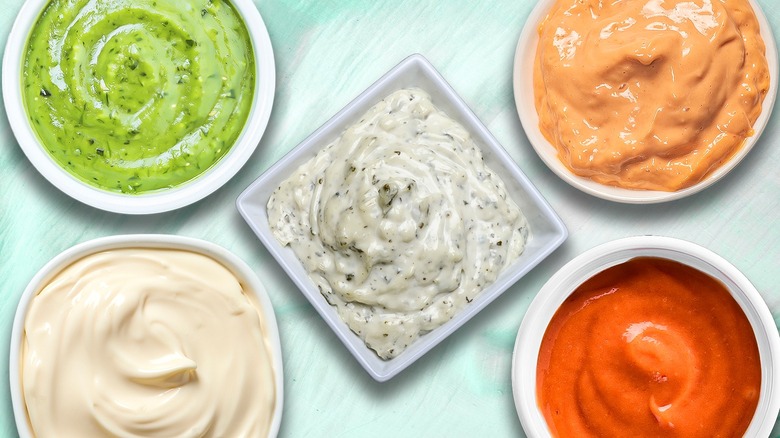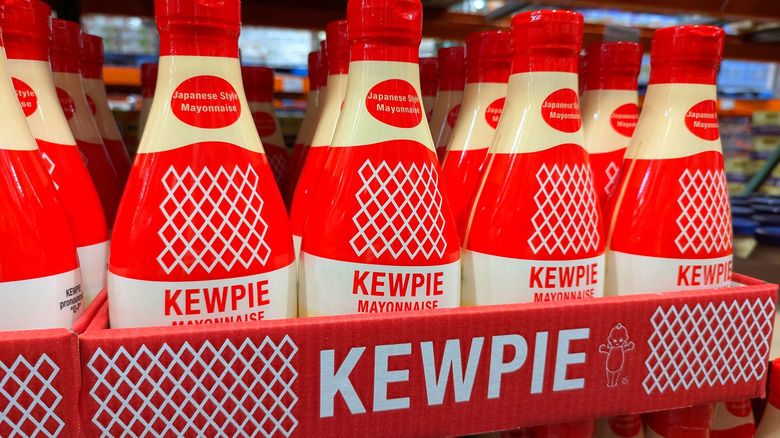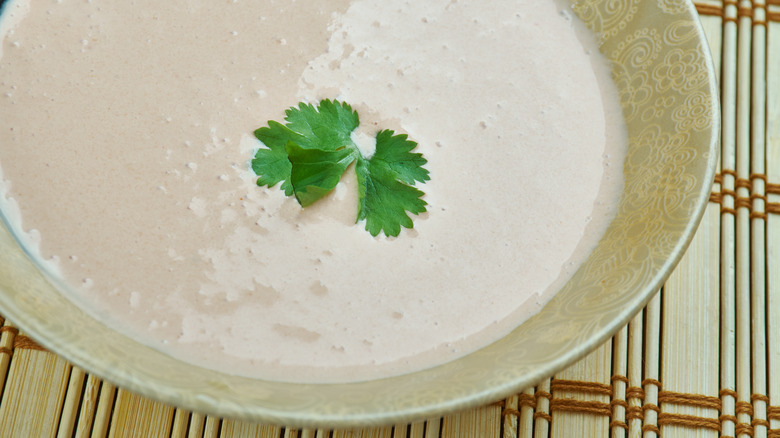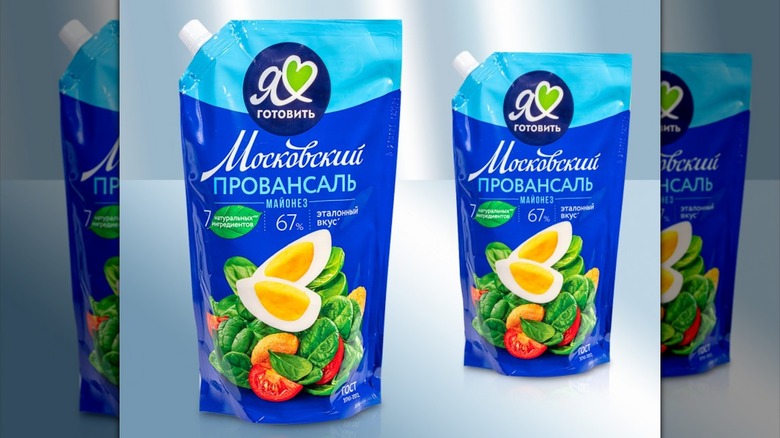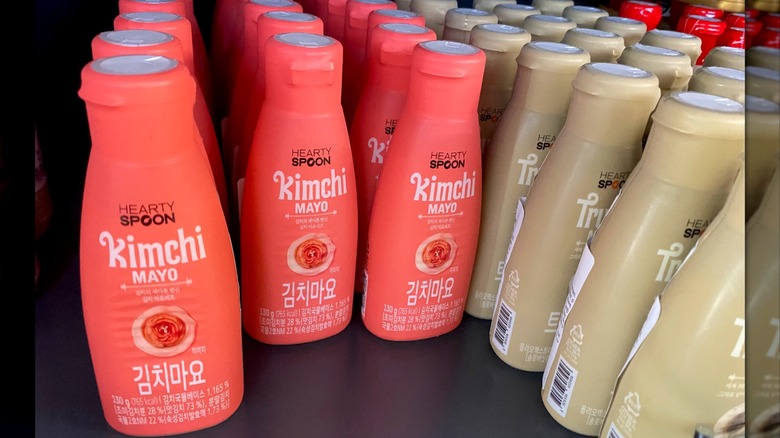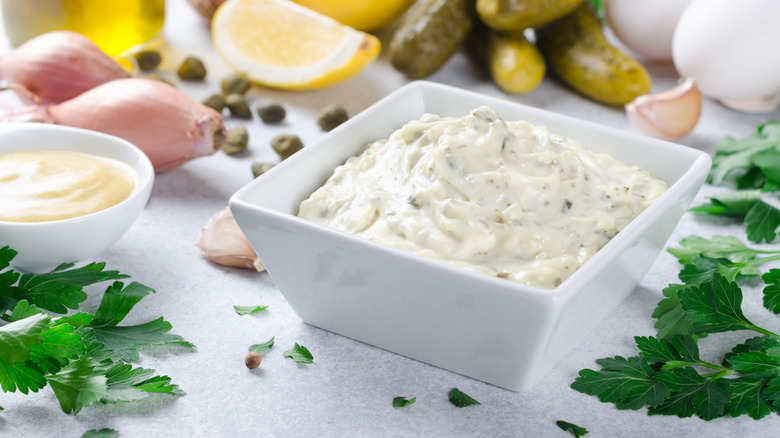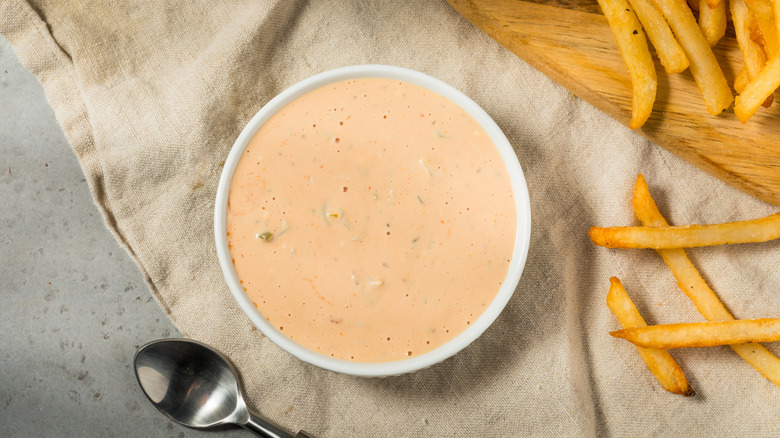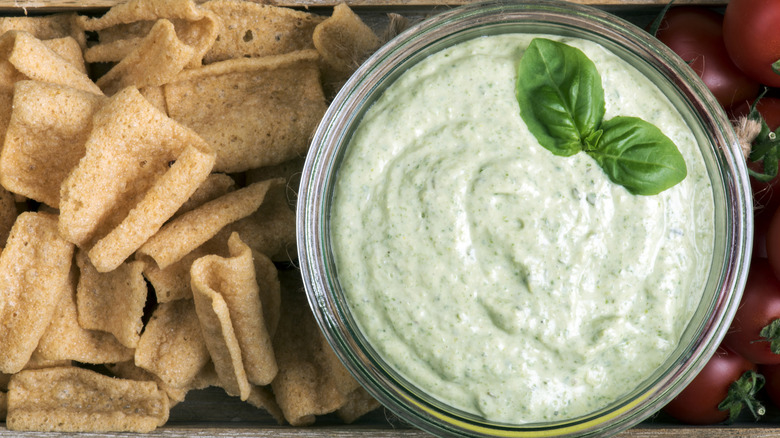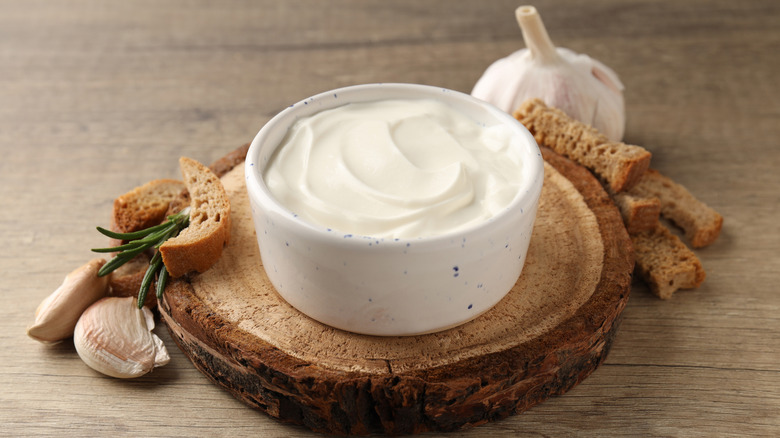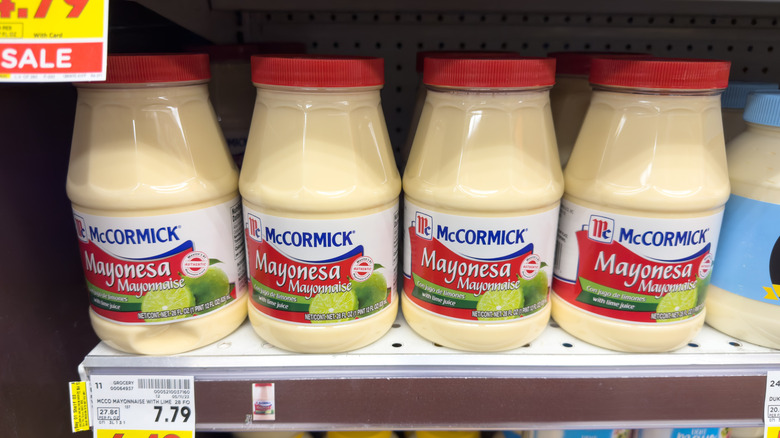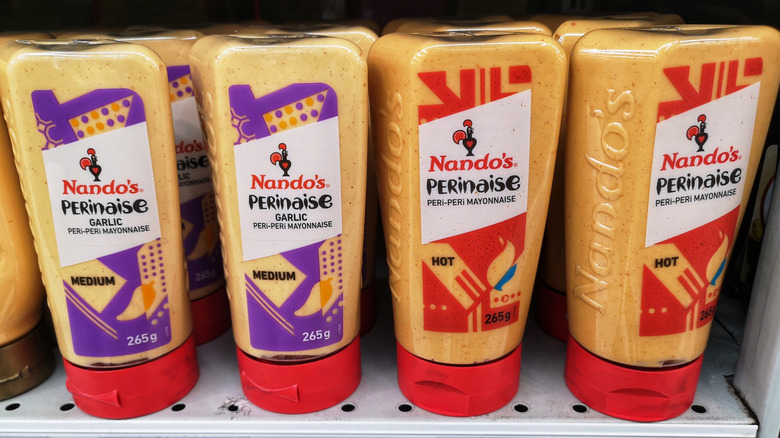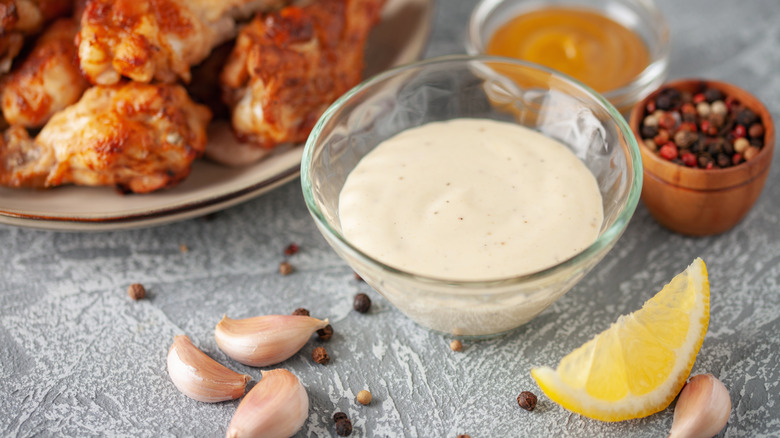13 Different Mayonnaise Variations You Can Find Around The World
We may receive a commission on purchases made from links.
Mayo is arguably one of the most divisive condiments. Some people won't touch the stuff, while others drown their food in it. But, if you love this creamy sauce, we've got great news: there are plenty of variations you haven't tried!
First things first, mayo isn't just any creamy spread. There are rules about what can and cannot be labeled as mayonnaise. According to federal regulations, mayonnaise must contain at least 65% oil, an acidifying component such as vinegar or lemon juice, and egg yolk. In the United States, mayo has a thick consistency, often requiring a knife to spread. It's creamy yet mild, with a slightly tangy taste that blends well with many savory dishes.
These 13 different mayonnaise variations have a similar enough consistency to be used as spreads or dips, or as an ingredient in salad dressing. To stay consistent, our list focuses on mayonnaise variations that also contain oil, egg yolk, and vinegar as primary components. However, they may be used in different ratios or mixed with other ingredients. A few recipes only differ slightly from American mayo, while others include wildly unique ingredient combinations. Some use mayo as a base, but have taken such a detour that they've formed a new sauce altogether. So, whether you're looking to spice up homemade mayo or simply want to purchase an interesting new condiment, the following options offer the perfect inspiration.
Kewpie (Japan)
Kewpie is Japan's favorite mayo, and you'll find these red-capped bottles in plenty of homes nationwide. The exact ingredients vary by country, but we're focusing on the authentic Japanese version. Like most commercially available mayonnaise, it's made with vegetable oil, using a blend of canola and soybean, plus egg yolks. It also contains vinegar, salt, spices, and natural flavor, and has monosodium glutamate (aka MSG), giving it that yummy, umami flavor that everyone loves.
In our ranking of store-bought mayonnaise brands, Kewpie placed in the upper half of the list and was praised for its smooth texture and complex flavor. It comes in a squeeze bottle rather than a glass jar, so you can expect a smoother, thinner condiment that can easily be spread across sandwiches or drizzled over pizzas. In Japan, it's used on everything from sushi to takoyaki (fried octopus balls), but can also be a standard dip or mixed into dressings. It's also the best mayo for egg salad because it has that extra umami element.
You can pick up a bottle of Kewpie at most major retailers. However, the American version replaces MSG with yeast and adds sugar. Read that ingredient label carefully, and if you want the authentic Japanese-made stuff, buy a bottle online through Amazon's official Kewpie store.
Salsa golf (Argentina)
If you're a mayo-lover, chances are, you've already tried salsa golf without even knowing it. It's merely a blend of ketchup and mayo, two tried-and-true staples. Most North Americans grab these condiments and mix the sauce themselves. However, Argentines felt this sauce merited its own name and proper packaging.
Origin stories vary. Some say a group of Argentine golfers started the trend while trying to improve their shrimp cocktail (hence the name), while others believe the Nobel Prize-winning scientist Luis Federico Leloir invented it. But if one thing is certain, it's that this sauce is wildly popular in Argentina, where you'll find it in every grocery store. However, golf sauce isn't exclusive to Argentina. Similar products go by different names around the world, such as Rot Weiß in Germany, burger sauce in the U.K., or fry sauce and fancy sauce in the U.S. Throughout Latin America, you may also see it labeled as salsa rosada (pink sauce), with some recipes incorporating lime or occasionally hot sauce.
The uses for salsa golf feel self-explanatory. If you'd put ketchup or mayo on something, you can put salsa golf on it. Making your own is also self-explanatory, and we've even done scientific experimentation to determine the perfect ratio of ketchup to mayo (spoiler alert, it's 50-50). And if you're not into experimenting, Heinz launched Mayochup for those too lazy to mix their own.
Mayonnaise Provençal (Russia)
Mayonnaise plays a prominent role in Russian cuisine, where it's incorporated into soups, salads, mains, and more. One popular mayo-heavy Russian dish is the Olivier salad, one of the best egg salad variations from around the world. However, they don't use just any old mayo. They use mayonnaise Provençal, also known as Russian mayonnaise.
Technically speaking, mayonnaise Provençal was popular throughout the Soviet Union, so you won't only find it in Russia, but several ex-Soviet countries. Traditional mayonnaise Provençal differs from the American variety because it uses refined sunflower oil instead of soybean oil. Recipes also include whole eggs, sugar, salt, mustard, and lemon juice. In Soviet times, sugar was a helpful addition since it extended the condiment's shelf life. But overall, Russian mayo is less sweet and vinegary, and more savory than its American counterpart.
Russian mayonnaise is also on the thinner side, which may be why it works so well in multiple dishes, and even as a soup topping. If you're cooking Russian recipes, like shuba (also known as herring under a fur coat), you'll need to use the right mayo to stay authentic. Luckily, you can find brands like Moskovskiy Provansal online or at specialty stores.
Kimchi mayo (South Korea)
Mayonnaise wasn't commonplace in South Korea until the late 20th century. Once this creamy condiment was widespread, it was only natural that locals began blending it with their favorite side dish, kimchi. Kimchi is divisive, but if you love spicy, fermented foods, this is your jam — especially since mixing it with mayo offers a welcome creaminess to tame that heat.
This condiment isn't purely Korean, but a Korean-American fusion. It's particularly popular among younger generations who love adding it to Western foods like corn dogs and sandwiches. To try it for yourself, you can purchase KPOP Foods Kimchi Mayo online. However, making your own results in fresher flavors and recipes is surprisingly simple (assuming you're buying premade kimchi). Just add chopped up kimchi to your mayonnaise. Recipes typically call for ⅓ cup of kimchi to ⅔ cup of mayo, but feel free to adjust to taste. And remember that a little toasted sesame oil can help blend the two while contributing a nutty, umami flavor.
Kimchi mayo is a fun twist on conventional mayonnaise, but it doesn't pair well with everything. Personally, we're not fans of kimchi mayo in sweeter dishes, such as Waldorf salad. We'd stick to savory meals that could use some spice, such as grilled cheeses or burgers. Kimchi mayo fans also highly recommend drizzling it over cheese fries.
Remoulade (France)
Although remoulade is popular worldwide, it was born in northern France. Recipes vary, but the traditional version contains mayonnaise, green herbs such as parsley and tarragon, capers, cornichons, and, sometimes, anchovy essence or paste. Some remoulades also include mustard, horseradish, or both. But if you really want fire, try Louisiana's rendition. Given the state's history as a French colony, it's no surprise locals gave this condiment their own twist. The result is a spicier, richer remoulade often made with the likes of Creole mustard, cayenne pepper, hot sauce, and lemon juice.
This condiment is similar to tartar sauce, but there's a clear difference between tartar sauce and remoulade. Tartar sauce is tangier with a simpler ingredient list, while remoulade has more herbs and complexity. This makes French remoulade the perfect flavor bomb for simple salads. It works beautifully in celeriac remoulade, a French salad made of shredded celery root. The spicier Louisiana remoulade is better suited to crab cakes and po'boys. It's also one of the best French fry dipping sauces for those bored with ketchup.
Comeback sauce (Mississippi)
Comeback sauce was born in Jackson, Mississippi, at the Greek-owned restaurant The Rotisserie. The creator, Alex Dennery, aimed to make a simple house dressing, but accidentally created a Southern classic. It's similar to special sauce or burger sauce, but has a distinct flavor profile that pulls from specific ingredients. The sauce starts with a base of mayonnaise and ketchup and then adds pantry staples such as chili sauce, Worcestershire sauce, lemon juice, and various seasonings, including garlic powder, onion powder, black pepper, and dry mustard. The result is a sauce that ticks many boxes. It's creamy, tangy, savory, and spicy all at once.
It's no shocker that this dressing took on a life of its own. Pretty soon, people were requesting it on burgers, chicken, fries, and the like. Thanks to its craveworthy appeal, comeback sauce kept people comin' back for more. But thankfully, you don't have to travel to Jackson to experience it. This tasty sauce has spread all over the South, available in restaurants and bottled varieties. Walmart sells Duke's Mississippi Comeback Sauce, and fast food joints like KFC and Raising Cane's have their own takes.
Maionese verde (Brazil)
Maionese verde literally means green mayonnaise, and the name couldn't be more fitting. Recipes vary, but always feature a blend of herbs that lend a natural green color. Think spinach, chives, parsley, tarragon, and basil. A squeeze of lemon or lime juice adds brightness, while optional mustard, garlic, or jalapeños add a kick. Unlike many mayos on this list, maionese verde isn't always spicy, but you can rely on its fresh, herby flavors.
You won't typically find this mayo in U.S. stores. Your safest bet is a trip to Brazil — or your blender. Some home chefs use whole milk or hard-boiled eggs as the base. However, mayonnaise is an easy starting point when making homemade maionese verde, and it makes it super creamy. Blend herbs, lemon juice, and optional ingredients, then fold the mixture into your preferred mayo. Brazilians enjoy this sauce with everything from hot dogs to coxinhas (their version of croquettes), but it's just as delicious as a sandwich spread or thinned with vinegar for a green goddess-style dressing.
Joppie sauce (The Netherlands)
Joppie sauce is the Netherlands' signature spiced mayo. The popular bottled version by Elite keeps its exact recipe under wraps, making it hard to replicate. However, homemade Joppie recipes blend mayonnaise with curry powder, chopped onion, mustard, turmeric, tomato paste, vinegar, and a touch of sugar, salt, and pepper.
Technically, Joppie sauce wouldn't be classified as a mayonnaise according to U.S. law. Federal regulations prohibit turmeric (often found in curry powder) as an ingredient in mayo because it lends a golden color that could be mistaken for egg yolk. Why that's a problem, we're not quite sure, but we'll let it slide.
Joppie sauce has a tangy flavor with a slight sweetness and a smooth texture. The Dutch typically use it on crispy fries, but we think it would be equally delicious over roasted veggies or barbecued meat. Outside of online specialty stores, it's hard to find in the U.S., but other European countries have similar curry-inspired counterparts. Some U.K. grocers sell chip shop curry mayo, made with turmeric, tomato purée, and warming spices, while Denmark has karrysild, a briny sauce featuring curry powder, herring, and mayo.
Ajonesa (Spain)
Ajonesa is a portmanteau of the words ajo (garlic) and mayonesa (mayonnaise), two popular ingredients in Spanish cuisine. This sauce is beautifully simple, relying primarily on mayo, garlic, and lemon juice. Although similar to aioli, ajonesa starts with real mayo, meaning it contains eggs rather than being an emulsion of solely olive oil and garlic.
In Spain, you can find ajonesa at most major grocery stores. Popular brands include Chovi and Pintón. It's also easy to make something similar by following our guide to transforming mayonnaise into garlicky mayo. Basically, stir finely chopped or pressed garlic into your mayo and add lemon juice to taste. The resulting flavor is exactly as you'd expect. It's rich, creamy, and so garlicky you'll be reaching for those breath mints. Garlic lovers can use this condiment just as they would mayo. It functions as a sandwich spread or as a tasty topping for meat and fish. Keeping with Spanish tradition, it's also delicious on potato omelettes or patatas bravas.
Mexican mayonnaise (Mexico)
Mexican mayonnaise is just regular mayonnaise with a dash of lime juice, but the latter makes a big difference. If you're always squeezing citrus over your meal, you need lime juice in mayonnaise. It brightens the flavor and cuts through the richness, making this creamy condiment lighter on the palate.
In Mexico, McCormick is the preferred brand, and you can easily find it in U.S. stores like Publix or Walmart. Don't get thrown off by the packaging. The label may say it's made with "limones," but that's because in Mexico, "limones" actually refers to limes, while "limas" means lemons. Of course, you can always make your own Mexican mayonnaise by squeezing fresh lime juice into regular mayo, adjusting the tartness to taste.
If you've ever tasted authentic Mexican elote (grilled street corn), it likely came with this lime-infused mayonnaise. Corn aside, Mexican mayonnaise can replace regular mayo in almost any dish. Just make sure it goes well with citrus. Salad dressings, coleslaws, or fish sandwiches work well. Or, use the Mexican mayo as a base for fish taco sauce or a spicy salsa rosada.
Traditional Belgian mayonnaise (Belgium)
Few places take mayo as seriously as Belgium. Fries are believed to be a Belgian invention, and mayo is central to the country's fritkot (fry shop) culture. Belgians actually eat more fries per capita than any other nation, and their condiment of choice is almost always mayonnaise. Specifically, traditional Belgian mayonnaise, which many locals (and online fans from across the globe) claim is the best mayo in the world.
What makes Belgian mayo so different? A 1955 royal decree set strict standards for the condiment. Any Belgian product labeled "mayonnaise" was required to contain 80% fat (in the form of vegetable oil) and 7.5% egg yolk to ensure quality. In Europe, most countries only require 70% fat and 5% egg yolk, while the United States only requires 65% fat. These regulations created a richer, creamier, and thicker spread. Belgian mayo also has a more pronounced flavor, which is less sweet, more savory, and deeply decadent.
These regulations eventually became tricky. Amid fears that foreign mayo producers might eat into Belgium's share in the market, the country implemented a new royal decree in 2016. The updated law said that anything labeled as mayonnaise could contain 70% fat and 5% egg yolk — but to protect Belgium's cultural legacy, the "traditional mayonnaise" label was reserved for products that met those original 80% fat and 7.5% egg yolk requirements.
Peri peri mayo (South Africa)
To truly grasp peri peri mayo, you must first understand its fiery foundations. The term peri peri comes from the Swahili "piri-piri," sometimes spelled "pili-pili," meaning pepper. Although the exact origin is debated, one theory traces it back to 15th-century Portuguese settlers in Mozambique, who blended local African bird's eye chili with the likes of garlic and red wine vinegar to make a tangy, spicy marinade. The sauce spread throughout southern Africa, where it remains popular today, but it wasn't until relatively recently that locals combined it with mayo.
Although people have been mixing peri peri with mayo for decades and it's tough to pinpoint its exact origins, the South African chain Nando's popularized the combination with its Perinaise. Nando's is known for flame-grilled chicken marinated in peri-peri sauce, made with peri-peri grown in southern Africa, so bottling Perinaise felt like a natural next step. Perinaise hit U.S. grocery stores in 2019 and is now sold at major retailers like Walmart.
Perinaise is not the only peri peri mayo contender in today's market. Heinz has since come out with Heinz [Seriously] Good Spicy Peri Peri Mayonnaise, and the British chain Marks & Spencer also sells its own peri peri mayo. Trader Joe's Peri Peri Sauce can also easily be combined with mayo for a DIY version. Whichever route you take, expect peri peri mayo to deliver zesty, slightly spicy flavors with hints of lemon and garlic. It pairs perfectly with grilled or barbecued meats, particularly peri peri chicken or burgers. It also adds a nice, flavorful twist to tacos, burritos, and quesadillas.
White BBQ sauce (Alabama)
Bob Gibson, founder of Big Bob Gibson BBQ, is the mastermind behind white BBQ sauce, aka Alabama white sauce. Created a century ago, Gibson's recipe was a way of keeping his pit-cooked chicken moist while adding punchy flavor. He started with mayo as the base, thinning it with apple cider vinegar and lemon juice and adding black pepper. The result was somewhere between a marinade and a dipping sauce.
Modern recipes have built upon Gibson's creation with Worcestershire sauce, garlic, or onion powder, as well as adding hot sauce, cayenne pepper, or horseradish for extra heat. It's tangy and creamy, but with an entirely unique flavor profile. You certainly pick up on acidity and spice, but neither is overwhelming.
White sauce has spread throughout the state's restaurant scene, becoming known as Alabama white BBQ sauce. Luckily, you don't need to travel to the South to experience it for yourself. The Tailgate Foodie White Lightning Alabama White BBQ Sauce is one of the highest-rated bottled barbecue sauces you've never heard of. It complements heavy Southern cuisine beautifully, with the extra vinegar and lemon cutting through heavy meats. It's also a tasty addition to side dishes such as corn, coleslaw, or roasted veggies.
